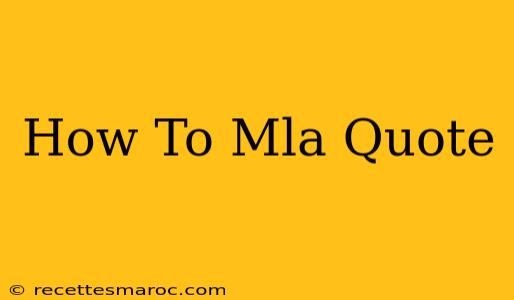Properly quoting sources is crucial for academic integrity. MLA (Modern Language Association) style is widely used in humanities disciplines, and understanding how to MLA quote accurately is essential for avoiding plagiarism and showcasing your research effectively. This guide will walk you through the process, covering different types of quotes and offering tips for seamless integration into your writing.
Understanding MLA Quotation Basics
The core principle of MLA quoting is to accurately represent the original source while clearly attributing it to the author. This involves using quotation marks for direct quotes and providing in-text citations that link the quote to a corresponding entry in your "Works Cited" page. Failing to do so constitutes plagiarism, with serious academic consequences.
Short Quotes (Under 4 Lines)
Short quotes are integrated directly into your sentence. Enclose the quoted material in double quotation marks (" "). Punctuation generally follows the quote, but sometimes it's integrated within the quote if the original text ends with punctuation.
Example: According to Smith, the study's findings were "surprisingly inconclusive" (Smith 12).
Note: Notice the period comes after the parenthetical citation.
Long Quotes (4 Lines or More)
Long quotes are set off from your text as a block quote. This is done by indenting the entire quote one inch from the left margin. Do not use quotation marks around a block quote. The final punctuation of the sentence comes before the parenthetical citation.
Example:
The study concluded that:
The impact of climate change is undeniable, affecting various ecosystems globally. The rising sea levels pose a significant threat to coastal communities, while altered precipitation patterns disrupt agricultural yields. This complex interplay of factors necessitates urgent intervention to mitigate the effects. (Jones 42)
Handling Variations in Quotes
Several scenarios require specific attention when quoting:
Omissions (...)
If you omit words from a quote, use ellipses (...) to indicate the omission. This shows that you haven't altered the original meaning. However, avoid using ellipses at the beginning or end of a quote unless the omission is crucial to your point.
Example: "The results were...unexpected, requiring further investigation" (Brown 56).
Additions [ ]
If you need to add words for clarity or grammar, enclose them in square brackets [ ]. This is used sparingly and only to maintain the original meaning and sentence flow.
Example: "The study revealed that [the participants'] responses varied significantly" (Green 21).
Emphasis (Italics)
You can add emphasis to specific words in a quote by italicizing them, but ensure the addition doesn't alter the original meaning. Include a note in brackets after the quote indicating the addition of italics.
Example: "The importance of the findings cannot be overstated" (Lee 78) [emphasis added].
Creating Your "Works Cited" Page
Your "Works Cited" page is a separate page at the end of your paper. It lists all the sources cited in your paper, following the specific MLA format. This page allows readers to easily locate the original sources. Each entry includes specific information depending on the source type (book, journal article, website, etc.). It's crucial to consult the latest MLA Handbook for the most current formatting guidelines.
Tips for Effective Quoting
- Choose quotes wisely: Select only quotes that directly support your argument and are crucial to your analysis. Avoid over-quoting.
- Integrate quotes smoothly: Don't just drop quotes into your text. Use transitions and introductory phrases to smoothly integrate them into your sentences and paragraphs.
- Contextualize quotes: Provide sufficient context around quotes to explain their relevance and meaning.
- Paraphrase when possible: Paraphrasing allows you to convey information from your source without directly quoting. Remember to still cite your source!
- Proofread carefully: Double-check all quotes and citations for accuracy. Errors can undermine your credibility.
By carefully following these steps and consulting the latest MLA Handbook, you can master the art of MLA quoting and produce high-quality, credible academic work. Remember, proper quoting is not just a matter of avoiding plagiarism; it’s a fundamental skill that demonstrates your understanding of academic writing and research.

